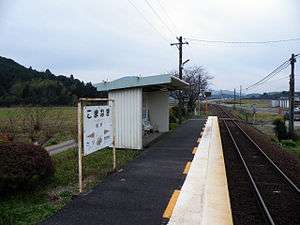Komanaki Station
Komanaki Station (駒鳴駅, Komanaki-eki) is a railway station on the Chikuhi Line operated by JR Kyushu, located in Imari, Saga Prefecture, Japan.[1][2]
Komanaki Station 駒鳴駅 | |
|---|---|
 Komanaki Station in 2008 | |
| Location | Japan |
| Coordinates | 33°19′10″N 129°58′20″E |
| Operated by | |
| Line(s) | ■ Chikuhi Line |
| Distance | 11.0 km from Yamamoto |
| Platforms | 1 side |
| Tracks | 1 |
| Construction | |
| Structure type | At grade |
| Bicycle facilities | Bike shed |
| Other information | |
| Status | Unstaffed |
| Website | Official website |
| History | |
| Opened | 1 March 1935 |
| Traffic | |
| Passengers (FY2015) | 7 daily |
| Location | |
 Komanaki Station Location within Japan | |
Lines
The station is served by the western section of the Chikuhi Line and is 11.0 km from the starting point of this section at Yamamoto.[3]
Station layout
The station, which is unstaffed, consists of a side platform serving a single track at grade. The platform is located on the opposite side of the track from the access road and is reached by means of a level crossing. There is no station building but a shelter is provided on the platform. A bike shed is provided near the station entrance.[2][3][4]
History
The private Kitakyushu Railway, which had a track between Hakata and Higashi-Karatsu by 1926 and had expanded southwards to {{STN|Yamamoto|Saga) by 1929. In a later phase of expansion, the track was extended west from Yamamoto to Imari, which opened as the western terminus on 1 March 1935. This station was opened on the same day as an intermediate station on the new track. The Kitakyushi Railway was nationalised on 1 October 1937 and Japanese Government Railways (JGR) assumed control of the station and designated the track which served it as part of the Chikuhi Line. With the privatization of Japanese National Railways (JNR), the successor of JGR, on 1 April 1987, control of the station passed to JR Kyushu.[5] [6]
Passenger statistics
In fiscal 2015, there were a total of 2,535 boarding passengers, giving a daily average of 7 passengers.[7]
References
- "JR Kyushu Route Map" (PDF). JR Kyushu. Retrieved 3 March 2018.
- "駒鳴" [Komanaki]. hacchi-no-he.net. Retrieved 1 April 2018.
- Kawashima, Ryōzō (2013). 図説: 日本の鉄道 四国・九州ライン 全線・全駅・全配線・第5巻 長崎 佐賀 エリア [Japan Railways Illustrated. Shikoku and Kyushu. All lines, all stations, all track layouts. Volume 5 Nagasaki Saga area] (in Japanese). Kodansha. pp. 14, 83. ISBN 9784062951647.
- "駒鳴" [Komanaki]. Retrieved 1 April 2018. Blog entry with good photographic coverage of station facilities especially the old station building, which has since been demolished.
- Ishino, Tetsu; et al., eds. (1998). 停車場変遷大事典 国鉄・JR編 [Station Transition Directory - JNR/JR] (in Japanese). I. Tokyo: JTB Corporation. pp. 224–5. ISBN 4533029809.
- Ishino, Tetsu; et al., eds. (1998). 停車場変遷大事典 国鉄・JR編 [Station Transition Directory - JNR/JR] (in Japanese). II. Tokyo: JTB Corporation. pp. 726–7. ISBN 4533029809.
- "佐賀県統計年鑑(平成28年版)" [Saga Prefecture Statistics Yearbook 2016 Edition]. Saga Prefectural Government website. Retrieved 23 March 2018. See table 12-7 at section under Transportation and Communications.
| Wikimedia Commons has media related to Komanaki Station. |